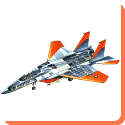 F-15 Eagle — The McDonnell Douglas (now Boeing) F-15 Eagle is a twin-engine, all-weather tactical fighter designed by McDonnell Douglas to gain and maintain air superiority in aerial combat. It is considered among the most successful modern fighters with over 100 aerial combat victories with no losses in dogfights. Following reviews of proposals, the United States Air Force selected McDonnell Douglas’ design in 1967 to meet the service’s need for a dedicated air superiority fighter. The Eagle first flew in July 1972, and entered service in 1976. The F-15 is expected to be in service with the U.S. Air Force past 2025.
F-15 Eagle — The McDonnell Douglas (now Boeing) F-15 Eagle is a twin-engine, all-weather tactical fighter designed by McDonnell Douglas to gain and maintain air superiority in aerial combat. It is considered among the most successful modern fighters with over 100 aerial combat victories with no losses in dogfights. Following reviews of proposals, the United States Air Force selected McDonnell Douglas’ design in 1967 to meet the service’s need for a dedicated air superiority fighter. The Eagle first flew in July 1972, and entered service in 1976. The F-15 is expected to be in service with the U.S. Air Force past 2025.
Since the 1970s, the Eagle has also been exported to Israel, Japan, and Saudi Arabia. Despite originally being envisioned as a pure air superiority aircraft, the design proved flexible enough that an all-weather strike derivative, the F-15E Strike Eagle, was later developed, and entered service in 1989.
Development
Following studies in 1964–1965, the U.S. Air Force developed requirements for an air superiority fighter in October 1965. Then on 8 December 1965, the Air Force issued a request for proposals (RFP) for the new fighter. The request called for both air-to-air and air-to-ground capabilities. Eight companies responded with proposals. In the following study phase, four of these companies developed some 500 design concepts. Typical designs featured variable-sweep wings, weighed over 60,000 lb (27,200 kg), included a top speed of Mach 2.7 and a thrust-to-weight ratio of 0.75. The designs were not accepted by the Air Force as they compromised fighter qualities for ground attack qualities. Acceptance of the Energy-Maneuverability (E-M) theory by the Air Force led to a change in requirements for improved maneuverability by the spring 1967. The design mission weight was reduced to 40,000 lb (18,100 kg), top speed reduced to Mach 2.3–2.5 and thrust-to-weight ratio increased to 0.97.
In 1967 U.S. intelligence was surprised to find that the Soviet Union was producing a large fighter aircraft, the MiG-25 ‘Foxbat’. It was not known in the West at the time that the MiG-25 was designed as a high-speed interceptor, not an air superiority fighter, so its primary asset was speed, not maneuverability. The MiG-25’s huge tailplanes and vertical stabilizers (tail fins) hinted at a very maneuverable aircraft, which worried the Air Force that its performance might be better than its U.S. counterparts. In reality, the MiG’s large fins and stabilators were necessary to prevent the aircraft from encountering inertia coupling in high-speed, high-altitude flight.
The F-4 Phantom II of the USAF and U.S. Navy was the only fighter with enough power, range, and maneuverability to be given the primary task of dealing with the threat of Soviet fighters while flying with visual engagement rules. As a matter of policy, the Phantoms could not engage targets without positive visual identification, so they could not engage targets at long ranges, as designed. Medium-range AIM-7 Sparrow missiles, and to a lesser degree even the AIM-9 Sidewinder, were often unreliable and ineffective at close ranges where it was found that guns were often the only effective weapon. The Phantom did not originally have a gun, but experience in Vietnam led to the addition of a gun. An external gun pod was tried and later the M61 Vulcan was integrated internally on the F-4E.
Design
The F-15 has an all-metal semi-monocoque fuselage with a large cantilever shoulder-mounted wing. The empennage is metal and composite construction, with twin aluminum/composite honeycomb fins with boron-composite skins, resulting in an exceptionally thin tailplane and rudders with all-moving composite horizontal tail surfaces outboard of the fins. The F-15 has a spine-mounted air brake and retractable tricycle landing gear. It is powered by two Pratt & Whitney F100 axial-flow turbofan engines with afterburners mounted side-by-side in the fuselage. The cockpit is mounted high in the forward fuselage with a one-piece windscreen and large canopy to increase visibility.
The F-15’s maneuverability is derived from low wing loading (weight to wing area ratio) with a high thrust-to-weight ratio enabling the aircraft to turn tightly without losing airspeed. The F-15 can climb to 30,000 ft (10,000 m) in around 60 seconds. The thrust output of the dual engines is greater than the aircraft’s weight, thus giving it the ability to accelerate in a vertical climb. The weapons and flight control systems are designed so that one person can safely and effectively perform air-to-air combat. The A and C-models are single-seat variants that make up the bulk of F-15 production. B and D-models add a second seat behind the pilot for training. E-models use the second seat for a bombardier/navigator. Visibly, the F-15 has a unique feature vis a vis other modern fighter aircraft in that it does not have the distinctive turkey feather aerodynamic exhaust petals covering its engine nozzles. This is because the petal design on the F-15 was problematic and could fall off in flight; therefore they were removed, resulting in a 3% drag increase.
 Kids Portal For Parents India Kids Network
Kids Portal For Parents India Kids Network
